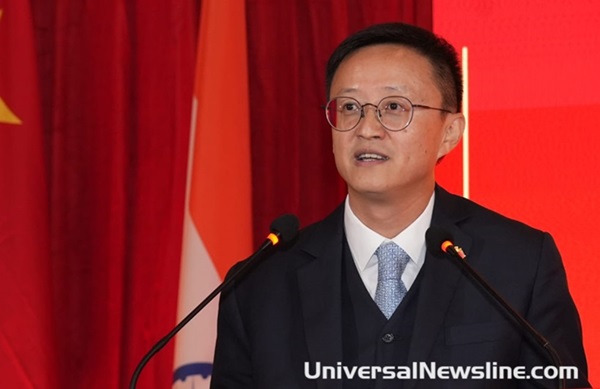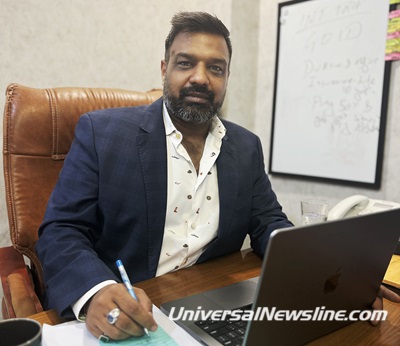 |
| Kong Xianhua, Consul General of China in Mumbai |
Commending on India's significant achievements in 2023, the Chinese Consul General Kong Xianhua, struck an optimistic outlook for India and China, and he opined that extensive cooperation between the neighboring countries could result in remarkable achievement and harvest for both Sino-Indian relations.
Amid the current difficult times between the two countries, and recalling watching Raj Kapoor's film Awaara during his childhood, Mr Kong Xianhua, Consul General of China in Mumbai, opened up about his vision for a greater co-operation and collaboration between India and China speaking exclusively to Paresh B Mehta, editor of Universal Newsline.
What is your individual perspective regarding the booming Indian economy?
India’s economic growth ranks the first place among all major economies in 2023. There is no doubt that India has become a key economic powerhouse in the world. India is making great efforts in developing manufacturing, infrastructure and digitalization, which are the pillars to sustain India’s fast growth in the future. Without being noticed, China and India have conducted extensive cooperation in those fields. In fact, China and India are highly complementary in various aspects. I’m pretty sure as long as China and India cooperate closely with each other, both the countries will reach our own development goal.
Could you briefly list about China's progress in the year gone by?
China’s GDP has grown by 5.2% to over $17.7 trillion USD in 2023 and contributed over 30% of the global economic growth, remaining the main engine of global economy. With 41.76 trillion yuan of export and import value, China has secured its position as the largest trader of goods for 7 consecutive years. China's auto export exceeded 5 million last year, pushing it to be the No.1 auto exporter in the world.
India and China should co-operate closely to reach our own developmental goal. That is true, but what are the Chinese government's initiatives to welcome more tourists from India? And what are further steps required for the same?
Starting from March, 2023, we fully resumed the acceptance of all types of visa applications including tourist and business visas. We have issued over 50,000 visas in 2023, a fifty-fold increase compared to 2022, among which business visas are over 40,000 and tourists visas are over 1,000.
The visa application is becoming easier and more convenient. We have streamlined visa application procedures, application forms and required materials, implemented temporary fee reductions for visa applicants. Applicants can get their visas in only 4 days.
Indian tourists to China are not enough. The main reason behind is that there is no direct flight nowadays. I do hope that the Indian government will come up with a final decision on resuming direct flights in 2024.
Don't you feel that with the increase in Chinese tourists to India and vice versa, the cultural bonds between the both countries could receive a boost?
I always encourage Indian young friends to visit China and see the remarkable development achievements with their own eyes. Since China and India are so similar to each other, I believe they would be more confident in the future of India after witness what China has achieved. I have mentioned that we have taken actions to encourage more Indian tourists to visit China and explore various facets of China. Unfortunately, Chinese tourists are still unable to get Indian visa.
India has seen rapid development and significant changes over these years. Chinese people must have a look-see. Moreover, there are many world-renowned historical sites and scenic spots. I wish that the Indian government could resume visa service to Chinese citizens and encourage them to explore incredible India.
What was your individual perception regards to India and its citizens before you joined the diplomatic profession. Could you please point out one or more issues or about Indian culture - that came to you as a pleasant surprise?
As a matter of fact, my connections with India dated back to my childhood. The first foreign movie I watched is Awaara, the masterpiece of all time in Indian movie history. I can still remember the song Awaara Hoon. Before I joined the diplomatic profession, I worked in Shijiazhuang City, Hebei Province, where Dr. Kotnis fought and died. My office is very close to a war martyr cemetery where a statue of Dr. Kotnis stands and receives people’s tributes.
All Chinese people, including me, are very grateful for his great sacrifice to Chinese people. That’s why we initiated Dr. Kotnis Friendship School Program with Solapur Municipality. We are also cooperating with a movie production team to make a documentary about Dr. Kotnis.
During the Spring Festival holiday, I visited the Ajanta Caves and Ellora Caves. I was deeply impressed by the vivid mural wall paintings and exquisite carvings. The Mogao caves in China, which contains some of the finest examples of Buddhist art in China, were greatly influenced by India from the very beginning. It’s a pity that no written record of the Ajanta Caves exists in India. But Xuan Zang, the great Chinese buddhist monk and scholar, in his the Great Tang Records on the Western Regions, gave us the most detailed descrption about the marvelous place.
After One and a half years of stay in India, what impressed me most is that so long the history of cultural exchange is between us and so deep is the influence of that exchange on both of us.
(The opinions expressed by Kong Xianhua, the Chinese Consul General in this interview are purely his personal views)





